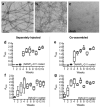Self-assembled peptide nanofibers raising durable antibody responses against a malaria epitope
- PMID: 22695068
- PMCID: PMC3392361
- DOI: 10.1016/j.biomaterials.2012.05.041
Self-assembled peptide nanofibers raising durable antibody responses against a malaria epitope
Abstract
Biomaterials that modulate innate and adaptive immune responses are receiving increasing interest as adjuvants for eliciting protective immunity against a variety of diseases. Previous results have indicated that self-assembling β-sheet peptides, when fused with short peptide epitopes, can act as effective adjuvants and elicit robust and long-lived antibody responses. Here we investigated the mechanism of immunogenicity and the quality of antibody responses raised by a peptide epitope from Plasmodium falciparum circumsporozoite (CS) protein, (NANP)(3),conjugated to the self-assembling peptide domain Q11. The mechanism of adjuvant action was investigated in knockout mice with impaired MyD88, NALP3, TLR-2, or TLR-5 function, and the quality of antibodies raised against (NANP)(3)-Q11 was assessed using a transgenic sporozoite neutralizing (TSN) assay for malaria infection. (NANP)(3)-Q11 self-assembled into nanofibers, and antibody responses lasted up to 40 weeks in C57BL/6 mice. The antibody responses were T cell- and MyD88-dependent. Sera from mice primed with either irradiated sporozoites or a synthetic peptide, (T1BT*)(4)-P3C, and boosted with (NANP)(3)-Q11 showed significant increases in antibody titers and significant inhibition of sporozoite infection in TSN assays. In addition, two different epitopes could be self-assembled together without compromising the strength or duration of the antibody responses raised against either of them, making these materials promising platforms for self-adjuvanting multi-antigenic immunotherapies.
Copyright © 2012 Elsevier Ltd. All rights reserved.
Figures






References
-
- Purcell AW, McCluskey J, Rossjohn J. More than one reason to rethink the use of peptides in vaccine design. Nat Rev Drug Discov. 2007;6:404–14. - PubMed
-
- Corradin G, Kajava AV, Verdini A. Long synthetic peptides for the production of vaccines and drugs: a technological platform coming of age. Sci Transl Med. 2010;2:50rv3. - PubMed
-
- O’Hagan DT, De Gregorio E. The path to a successful vaccine adjuvant-the long and winding road. Drug Discov Today. 2009;14:541–51. - PubMed
Publication types
MeSH terms
Substances
Grants and funding
LinkOut - more resources
Full Text Sources
Other Literature Sources
Medical

